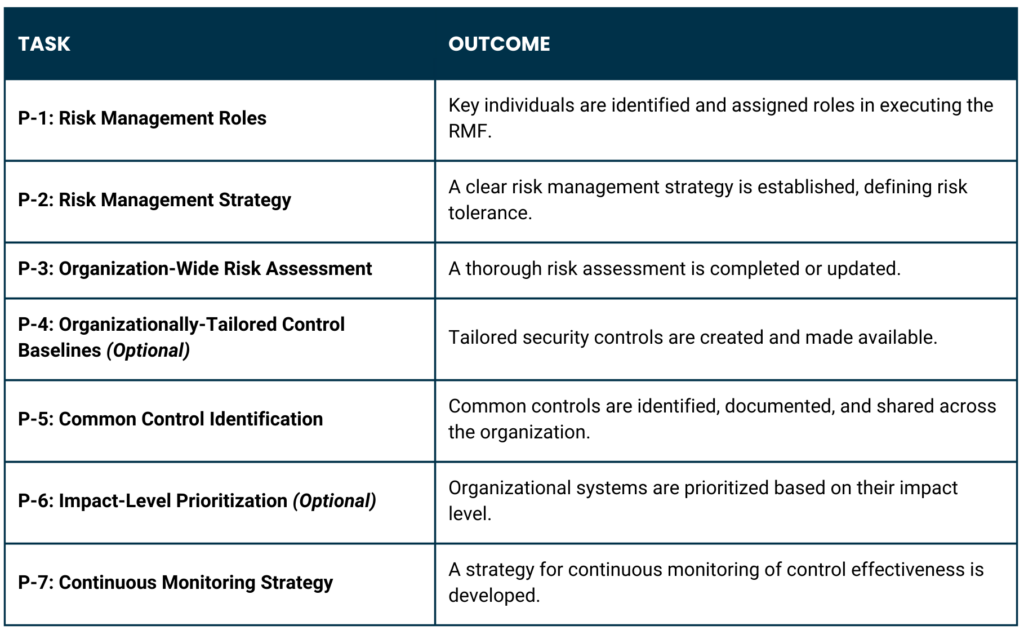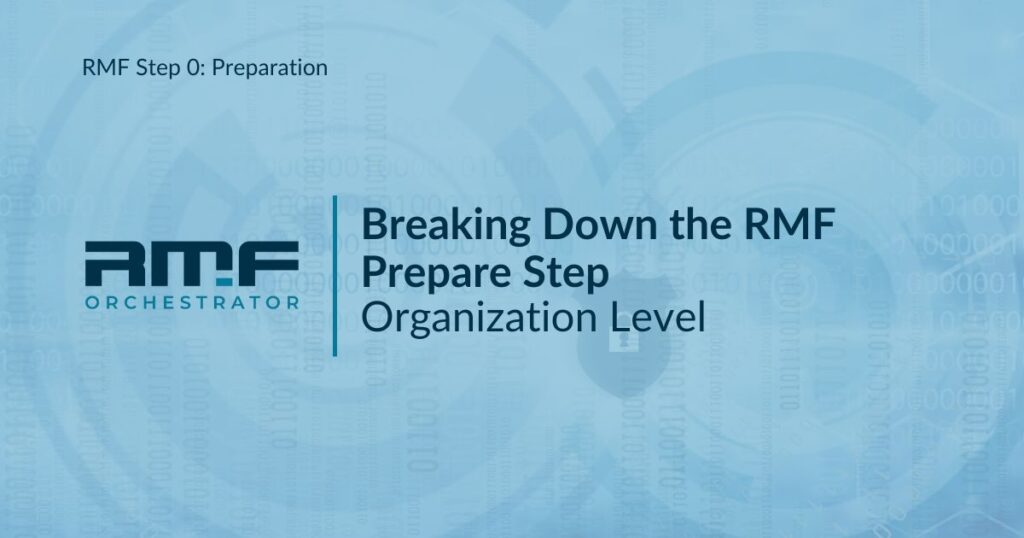The Risk Management Framework (RMF) is vital for any organization dealing with IT security and privacy. It helps to ensure systems meet federal compliance and security standards. But if you’ve ever worked through the RMF steps, you know it can be a complex and time-consuming process. That’s where RMF Orchestrator (RMF-O) comes in—designed to streamline and simplify each step, making it more manageable. In this post, we’ll break down the Prepare Step—specifically the Organizational Level—and explore how RMF-O can help make this easier for you.
What is the RMF Prepare Step?
The Prepare Step sets the foundation for all future RMF tasks. It helps organizations get ready to handle their security and privacy risks by establishing policies, strategies, and roles. Without this step, an organization risks running into gaps in their security and compliance practices.
Organization-Level Prepare Tasks
At the organization level, the Prepare Step is all about setting up frameworks and strategies that support your overall risk management efforts. Here’s a breakdown of the key tasks:

As you can see, the Prepare Step requires a lot of upfront work to ensure your organization is ready to take on security and privacy risk management.
Challenges Organizations Face in the Prepare Step
One of the biggest challenges is managing the sheer number of tasks and ensuring nothing falls through the cracks. Many organizations find it difficult to:
- Assign the right roles with clear responsibilities.
- Develop a comprehensive risk management strategy that aligns with their business goals.
- Keep their risk assessments up-to-date and relevant.
- Tailor security controls to their specific needs.
- Identify and inherit common controls effectively across multiple systems.
- Create a robust continuous monitoring strategy that keeps up with evolving threats.
These tasks are critical, but they can become overwhelming, especially for organizations with limited resources.
How RMF-O Simplifies the Prepare Step
RMF Orchestrator (RMF-O) was built to tackle these challenges head-on, offering features that simplify and streamline the process. Here’s how RMF-O can help:
1. Role Assignment Made Easy (Task P-1)
RMF-O allows you to easily set up and customize roles such as PMO, ISSO, ISSM, SCAR, SCA, and AO, ensuring that everyone knows their responsibilities. You can even create roles for supporting teams like auditors or the privacy officer. No more confusion about who is supposed to do what—RMF-O keeps everything organized and transparent.
Example: Say your organization needs to onboard a new ISSO. With RMF-O, you can quickly assign this role and ensure that all tasks and responsibilities related to the RMF process are clearly outlined and tracked.
2. Create a Risk Management Strategy (Task P-2)
A solid risk management strategy is crucial, but building one can be time-consuming. RMF-O helps streamline the process by guiding you through the creation of a strategy that aligns with your business objectives and risk tolerance.
RMF-O includes features like risk scoring for your systems and organization. It also helps you understand the impact of different risks, making it easier to determine your organization’s risk appetite.
3. Keep Risk Assessments Up-to-Date (Task P-3)
Keeping an organization-wide risk assessment current is a constant challenge. With RMF-O, your risk assessments can be updated automatically with real-time data from vulnerability feeds, status monitoring of NIST and STIG controls, and more. This saves you from the hassle of manually redoing assessments each time a new risk is identified.
4. Tailored Security Controls (Task P-4)
Tailoring security control baselines to your organization’s specific needs can be tricky. RMF-O lets you customize control baselines effortlessly, ensuring they fit your organization perfectly. You can also create Cybersecurity Framework Profiles to streamline security processes.
5. Manage Common Control Inheritance (Task P-5)
Identifying and managing common controls can be complex, especially when they’re inherited across multiple systems. RMF-O provides tools like matrix and Sankey diagrams to help you visualize how common controls are inherited throughout your organization, making it easier to track and document them.
6. Prioritize Systems by Impact Level (Task P-6)
If you’re managing multiple systems with the same impact level, RMF-O can help you prioritize them effectively, ensuring that your high-impact systems get the attention they deserve. This optional step can help you allocate resources more efficiently.
7. Continuous Monitoring with Live Data (Task P-7)
Continuous monitoring is essential to ensure your controls are still effective over time. RMF-O integrates with real-time data feeds, giving you live updates on the status of your security controls and vulnerabilities. This proactive approach allows you to stay ahead of potential issues before they become significant problems.
The Prepare Step can seem daunting, but RMF-O takes the complexity out of the process. By streamlining key tasks like role assignment, risk assessments, and control inheritance, RMF-O helps you focus on what matters—managing security and privacy risks effectively.
For more information on how RMF-O can help you through the RMF steps, explore our features page or schedule a demo today!

